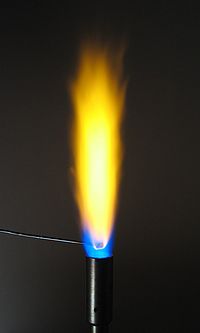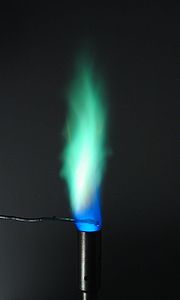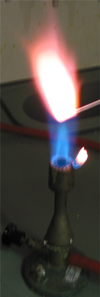
Colored fire
Encyclopedia
Colored fire is a common pyrotechnic effect used in stage productions, fireworks and by fire performers the world over. Generally, the color of a flame
may be red, orange, yellow, or white, and is dominated by blackbody radiation from soot
and steam
. When additional chemicals are added to the fuel burning, their atomic emission spectra can affect the frequencies of visible light radiation emitted - in other words, the flame will appear a different color dependent upon the chemical additives. Flame coloring is also a good way to demonstrate how chemicals change when subjected to heat and how they also change the matter around them.
Pyrotechnicians will generally use metal salts to color their flames. Specific combinations of fuels and co-solvents are required in order to dissolve the necessary chemicals. Color enhancers (usually chlorine donors) are frequently added too, the most common of which is polyvinyl chloride
. A practical use of colored fire is the flame test
, where metal cations are tested by placing the sample in a flame and analyzing the color produced.
Emitted colors depend on the electronic configuration of the elements involved. Heat energy from the flame excites electrons to a higher quantum level, and the atoms emit characteristic colors (photons with energies corresponding to the visible spectrum) as they return to lower energy levels.
pipe with holes drilled throughout and stuffed with garden hose onto campfires to create a variety of flame colors. An easier and more accepted method of coloring campfires has been fueled by commercial products. These packages of flame colorants are tossed onto a campfire
or into a fireplace to produce effects.
Although these chemicals are very effective at imparting their color into an already existing flame, these substances are not flammable alone. To produce a powder or solid that, when lit, produces a colored flame, the necessary steps are more complex. To get a powder to burn satisfactorily, both a fuel and oxidizer will probably be needed. Common oxidizers include
Many of these oxidizers also produce a colored flame by themselves.
Flame
A flame is the visible , gaseous part of a fire. It is caused by a highly exothermic reaction taking place in a thin zone...
may be red, orange, yellow, or white, and is dominated by blackbody radiation from soot
Soot
Soot is a general term that refers to impure carbon particles resulting from the incomplete combustion of a hydrocarbon. It is more properly restricted to the product of the gas-phase combustion process but is commonly extended to include the residual pyrolyzed fuel particles such as cenospheres,...
and steam
Steam
Steam is the technical term for water vapor, the gaseous phase of water, which is formed when water boils. In common language it is often used to refer to the visible mist of water droplets formed as this water vapor condenses in the presence of cooler air...
. When additional chemicals are added to the fuel burning, their atomic emission spectra can affect the frequencies of visible light radiation emitted - in other words, the flame will appear a different color dependent upon the chemical additives. Flame coloring is also a good way to demonstrate how chemicals change when subjected to heat and how they also change the matter around them.
Pyrotechnicians will generally use metal salts to color their flames. Specific combinations of fuels and co-solvents are required in order to dissolve the necessary chemicals. Color enhancers (usually chlorine donors) are frequently added too, the most common of which is polyvinyl chloride
Polyvinyl chloride
Polyvinyl chloride, commonly abbreviated PVC, is a thermoplastic polymer. It is a vinyl polymer constructed of repeating vinyl groups having one hydrogen replaced by chloride. Polyvinyl chloride is the third most widely produced plastic, after polyethylene and polypropylene. PVC is widely used in...
. A practical use of colored fire is the flame test
Flame test
A flame test is a procedure used in chemistry to detect the presence of certain metal ions, based on each element's characteristic emission spectrum. The color of flames in general also depends on temperature; see flame color....
, where metal cations are tested by placing the sample in a flame and analyzing the color produced.
Flame colorants
| Color | Chemical | Image |
|---|---|---|
| Carmine (Dark Red) | Lithium chloride Lithium chloride Lithium chloride is a chemical compound with the formula LiCl. The salt is a typical ionic compound, although the small size of the Li+ ion gives rise to properties not seen for other alkali metal chlorides, such as extraordinary solubility in polar solvents and its hygroscopic... |
 |
| Red | Strontium chloride Strontium chloride Strontium chloride is a salt of strontium and chloride. It is a typical salt, forming neutral aqueous solutions. Like all compounds of Sr, this salt emits a bright red colour in a flame; in fact is used as a source of redness in fireworks... |
|
| Orange | Calcium chloride Calcium chloride Calcium chloride, CaCl2, is a salt of calcium and chlorine. It behaves as a typical ionic halide, and is solid at room temperature. Common applications include brine for refrigeration plants, ice and dust control on roads, and desiccation... |
|
| Yellow | Sodium chloride Sodium chloride Sodium chloride, also known as salt, common salt, table salt or halite, is an inorganic compound with the formula NaCl. Sodium chloride is the salt most responsible for the salinity of the ocean and of the extracellular fluid of many multicellular organisms... (table salt) or Sodium carbonate Sodium carbonate Sodium carbonate , Na2CO3 is a sodium salt of carbonic acid. It most commonly occurs as a crystalline heptahydrate, which readily effloresces to form a white powder, the monohydrate. Sodium carbonate is domestically well-known for its everyday use as a water softener. It can be extracted from the... |
 |
| Yellowish Green | Borax Borax Borax, also known as sodium borate, sodium tetraborate, or disodium tetraborate, is an important boron compound, a mineral, and a salt of boric acid. It is usually a white powder consisting of soft colorless crystals that dissolve easily in water.Borax has a wide variety of uses... (Sodium Borate) |
|
| Green | Copper(II) sulfate, Boric Acid Boric acid Boric acid, also called hydrogen borate or boracic acid or orthoboric acid or acidum boricum, is a weak acid of boron often used as an antiseptic, insecticide, flame retardant, as a neutron absorber, and as a precursor of other chemical compounds. It exists in the form of colorless crystals or a... |
 |
| Blue | Copper(I) chloride Copper(I) chloride Copper chloride, commonly called cuprous chloride, is the lower chloride of copper, with the formula CuCl. The substance is a white solid sparingly soluble in water, but very soluble in concentrated hydrochloric acid... , Butane Butane Butane is a gas with the formula C4H10 that is an alkane with four carbon atoms. The term may refer to any of two structural isomers, or to a mixture of them: in the IUPAC nomenclature, however, butane refers only to the unbranched n-butane isomer; the other one being called "methylpropane" or... |
 |
| Violet | 3 parts Potassium sulfate Potassium sulfate Potassium sulfate is a non-flammable white crystalline salt which is soluble in water... , 1 part Potassium nitrate Potassium nitrate Potassium nitrate is a chemical compound with the formula KNO3. It is an ionic salt of potassium ions K+ and nitrate ions NO3−.It occurs as a mineral niter and is a natural solid source of nitrogen. Its common names include saltpetre , from medieval Latin sal petræ: "stone salt" or possibly "Salt... (saltpeter) |
|
| Purple | Potassium chloride Potassium chloride The chemical compound potassium chloride is a metal halide salt composed of potassium and chlorine. In its pure state, it is odorless and has a white or colorless vitreous crystal appearance, with a crystal structure that cleaves easily in three directions. Potassium chloride crystals are... |
 |
Emitted colors depend on the electronic configuration of the elements involved. Heat energy from the flame excites electrons to a higher quantum level, and the atoms emit characteristic colors (photons with energies corresponding to the visible spectrum) as they return to lower energy levels.
Campfire colorants
Flame colorants are becoming popular while camping. Scouts and other outdoor enthusiasts have placed sections of copperCopper
Copper is a chemical element with the symbol Cu and atomic number 29. It is a ductile metal with very high thermal and electrical conductivity. Pure copper is soft and malleable; an exposed surface has a reddish-orange tarnish...
pipe with holes drilled throughout and stuffed with garden hose onto campfires to create a variety of flame colors. An easier and more accepted method of coloring campfires has been fueled by commercial products. These packages of flame colorants are tossed onto a campfire
Campfire
A campfire is a fire lit at a campsite, to serve the following functions: light, warmth, a beacon, a bug and/or apex predator deterrent, to cook, and for a psychological sense of security. In established campgrounds they are usually in a fire ring for safety. Campfires are a popular feature of...
or into a fireplace to produce effects.
Although these chemicals are very effective at imparting their color into an already existing flame, these substances are not flammable alone. To produce a powder or solid that, when lit, produces a colored flame, the necessary steps are more complex. To get a powder to burn satisfactorily, both a fuel and oxidizer will probably be needed. Common oxidizers include
- Ammonium perchlorateAmmonium perchlorateAmmonium perchlorate is an inorganic compound with the formula NH4ClO4. It is the salt of perchloric acid and ammonia. It is a powerful oxidizer, which is why its main use is in solid propellants...
- Ammonium nitrate
- Barium nitrateBarium nitrateBarium nitrate with chemical formula Ba2 is a salt of barium and the nitrate ion.Barium nitrate exists as a white solid at room temperature. It is soluble in water, and like other soluble barium compounds, is toxic and should be handled with care...
- Barium chlorateBarium chlorateBarium chlorate is a white crystalline solid. It is an irritant, as are all barium compounds. If consumed, barium chlorate can cause nausea, vomiting, and diarrhea. It is used in pyrotechnics to produce a green color...
- Guanine nitrate
- Potassium nitratePotassium nitratePotassium nitrate is a chemical compound with the formula KNO3. It is an ionic salt of potassium ions K+ and nitrate ions NO3−.It occurs as a mineral niter and is a natural solid source of nitrogen. Its common names include saltpetre , from medieval Latin sal petræ: "stone salt" or possibly "Salt...
(saltpeter) - Potassium chloratePotassium chloratePotassium chlorate is a compound containing potassium, chlorine and oxygen atoms, with the molecular formula KClO3. In its pure form, it is a white crystalline substance. It is the most common chlorate in industrial use...
- Potassium perchloratePotassium perchloratePotassium perchlorate is the inorganic salt with the chemical formula KClO4. Like other perchlorates, this salt is a strong oxidizer and potentially reacts with many organic substances...
- Strontium nitrateStrontium nitrateStrontium nitrate is an inorganic compound with the formula Sr2. This colourless solid is used as an colorant in pyrotechnics.- Preparation:Strontium nitrate is typically generated by the reaction of nitric acid on strontium carbonate.....
- Sodium nitrateSodium nitrateSodium nitrate is the chemical compound with the formula NaNO3. This salt, also known as Chile saltpeter or Peru saltpeter to distinguish it from ordinary saltpeter, potassium nitrate, is a white solid which is very soluble in water...
Many of these oxidizers also produce a colored flame by themselves.

